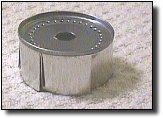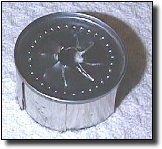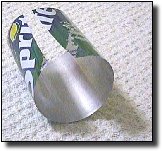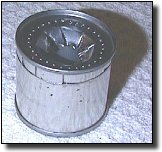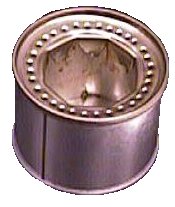 |
ALCOHOL BURNING BACKPACKING STOVE Contributed by: Shane Graber, 6/98 |
 |
| If you are like me
and you don't have a whole lot of money to shell out on
gear and/or you like to make your own gear, then this
page might be for you. All in all, this backpacking stove didn't cost
me a red cent to make (other than having to buy the
tomato paste cans and pop can -- which we already had)
and when completed it only weighs 1 oz (not including the
fuel or the pot stand). The stove was designed to hold no
more than 1/4 cup fuel which should be more than enough
to boil water and cook food on any backpacking trip. The original idea for this backpacking stove design came from the following (inactive) URL: http://www.uvol.com/scouts/stove/stoveUNPC.htm and from the original Trangia alcohol burning backpacking stove design. The above URL shows a person how to make an alcohol burning stove out of two popcans. This page was created in order to improve on the original design in both durability and efficiency of fuel consumption. This page is divided up into 4 sections:
which can be found below. MATERIALS LIST: The following materials will be needed to make the backpacking stove:
|
||
INSTRUCTIONS: STEP #1:
|
||
| STEP
#2:
|
||
| STEP
#3:
|
||
| STEP
#4:
|
||
| STEP
#5:
|
||
| STEP
#6:
|
||
| STEP
#7:
|
||
| STEP
#8: Make sure that the circle of aluminum is still centered in the stove. If it is not, take a pencil or equivalent and move it into the center of the stove. Once the aluminum circle is centered, slowly compress the burner section the remainder of the way into the base. The circle of aluminum should be securely in place at this point. |
||
| STEP
#9:
|
||
| STEP
#10: As an added measure, take a hammer and tap all the way around the edge of the burner section to firmly secure it in the base section of the stove. If you have problems with it staying down give it a really good rap all the way around with the hammer (taking care not to squash the stove in the process). With enough nudging the burner portion of the stove will stay put. |
||
BOIL TIME COMPARISONS: As stated above, the whole purpose of this project was to make a lightweight home-made alcohol burning stove similar in size and shape to a Trangia alcohol stove. Since I did not have access to a Trangia stove for this testing, I sent a final version of the above stove to a friend of mine, Todd Schlender, for the boil time comparisons between the home-made stove and a Trangia. The below data is a compilation of his testing. Apparatus: POT:
Mini-Trangia 28 pot (without lid, blackened bottom) Experimental Procedure: 16 oz of room temperature water was measured out into the Mini-Trangia 28 pot. The pot was left uncovered to monitor the boiling of the water during the test. The stove was then filled with methanol and then placed inside the pot stand. the stove was lit and the uncovered pot filled with water was placed on top of the stove stand. The amount of time required for the water to come to a rolling boil was then monitored and recorded. The following was the order that the stoves were tested in: First Stove Test: Tested home-made stove; once water boiled, noted boil time and then extinguished the flame. Then waited until the stove was cool enough to touch and removed it from the pot stand. Second Stove Test: Same as the First Stove Test (above) except with the Mini-Trangia 28. Third Stove Test: Retested home-made stove; waited until the water boiled and noted time, removed the pot (leaving burner going) and then refilled the pot with cool water, placed the new pot of room temperature water on the burner, and brought the water to a boil a second time and noted this boil time. Fourth Stove Test: Same as Third Stove Test (above) except with the Mini-Trangia 28. NOTE: Boil times are assumed to be less when a covered pot is used. Results and Discussion: The First and Second Stove Tests were a direct comparison of the stoves running cold -- as if the stoves were just removed from the pack and used for the first time out. The Third and Fourth Stove Tests were a comparison of how the stoves would react if more than one pot of water was heated during the meal with the stove left burning in between boilings. In the direct comparison testing (First and Second Stove Tests) it was found that both of the stoves brought the water to a rolling boil in 10.5 minutes. So, in this instance the stoves were identical if a person was just boiling one pot of food or drink. In the multiple boiling pots testing (Third and Fourth Stove Tests), it was found that the stoves acted differently. In both cases, the home-made stove brought both pots of water to a rolling boil in 10.5 minutes each. The Mini-Trangia 28, however, brought the first pot to a rolling boil in 10.5 minutes and the second pot to a rolling boil in 6.5 minutes. These results were very interesting to us. Why would the home-made stove take longer to boil the second pot of water than the Mini-Trangia 28? Also, why would the Mini-Trangia 28 boil the second pot of water faster than the first? In doing a Web search to answer these questions, we happened upon a message post that showed similar results with a Trangia when the burner was left running boiling one pot of water right after the other: Unfortunately, no theory was put forth to answer this question. The only theory that we could come up with was that as Todd put it: "[In theory] the hotter the stove burns, the faster the alcohol boils, which increases the pressure which jets the gas out faster which makes it burn hotter which brings us back to the beginning. So maybe if the Trangia gets a little bit hotter, which causes it to boil a little bit faster, which lets it get a little bit hotter, etc. etc. and it just takes the Trangia longer to get up to speed…" At this point, though, no further investigation has been done to prove or disprove this theory. It may be as simple as adding some sort of lightweight, flameproof, insulating layer to the outside of the home-made stove to keep the heat from dissipating from the home-made stove as quickly which would allow the alcohol to boil faster. Further work will have to be done in this area. Conclusions: As can be seen from the above data, the home-made stove compared well with the purchased Mini-Trangia 28 in the direct boil time comparison testing. Both stoves boiled the same amount of water in the same amount of time. The multiple boiling pots testing was where the differences were seen with the Mini-Trangia 28 boiling the second pot of water faster than the home-made stove. When a stove is used in camp, it is cold on the first time using it so using the home-made stove is a very good alternative to the Mini-Trangia 28 if only one pot of water is going to be boiled at that particular meal. If multiple pots of water are to be boiled, the Mini-Trangia 28 will save a person a couple of minutes of boil time on the second pot of water boiled which would turn into a savings in fuel. That's it. At this point the stove should look and act very much like a Trangia. The only thing that it lacks is a cap/simmer ring. Fill the stove with methanol (or equivalent fuel) and cook away. I still have some work to do on the pot stand for this stove. From initial testing, any pot stand for this kind of stove needs to have a significant amount of ventilation otherwise it will burn inefficiently, so keep that in mind when using the above stove. I have done some burn time testing on the above stove as well and I have gotten between 12 and 14 minutes of burn time from 1/8 cup of methanol which is comparable to the Trangia (burns 1/4 cup fuel in 20 to 25 minutes according to figures published in Campmor). I hope that you enjoy making this stove as much as I did. Also, feel free to modify the above stove design if you so choose. If you find a better or more efficient design I would definitely like to hear about it. Happy trails! Shane Grabersgraber@bigfoot.com
DISCLAIMER: |
||
Return to: [ Top of This Page ] [ Make Your Own Gear Page ]
 Remove the labels from the two empty
tomato paste cans. After removal of the paper labels some
glue may still be present on the tin cans. Remove this
dried glue from the cans by soaking a cottonball with
fingernail polish remover and rubbing the dried adhesive
until it is completely removed.
Remove the labels from the two empty
tomato paste cans. After removal of the paper labels some
glue may still be present on the tin cans. Remove this
dried glue from the cans by soaking a cottonball with
fingernail polish remover and rubbing the dried adhesive
until it is completely removed. Using the ruler and the marker, measure up
1.5 inches from the bottom of one of the tin cans and
mark all the way around the tin can with the marker at
the 1.5 inch mark. Set this can aside. This can will be
the base of the stove. On the second tin can, measure 1
inch up from the bottom and mark the 1 inch line all the
way around this can on this second can. This can will be
used as the burner portion of the stove. Take the tin
snips and cut the cans off at the 1.5 and 1 inch lines.
File down the sharp edges with the metal file for safety.
Using the ruler and the marker, measure up
1.5 inches from the bottom of one of the tin cans and
mark all the way around the tin can with the marker at
the 1.5 inch mark. Set this can aside. This can will be
the base of the stove. On the second tin can, measure 1
inch up from the bottom and mark the 1 inch line all the
way around this can on this second can. This can will be
used as the burner portion of the stove. Take the tin
snips and cut the cans off at the 1.5 and 1 inch lines.
File down the sharp edges with the metal file for safety. Measure 1/4 inch in from the edge of the 1
inch tall can and punch 32 holes around the inside of the
bottom of the can with the thumb tack. This creates the
burner holes where the fuel will vaporize out of the
stove once it is heated by the burning fuel. It will be
hard to puncture through the tin can with the thumbtack
but the reason that thumbtacks were used in this step was
because they make extremely small holes. You can also use
the smallest drillbit possible to drill the holes if
punching holes in the bottom is too difficult with a
thumbtack.
Measure 1/4 inch in from the edge of the 1
inch tall can and punch 32 holes around the inside of the
bottom of the can with the thumb tack. This creates the
burner holes where the fuel will vaporize out of the
stove once it is heated by the burning fuel. It will be
hard to puncture through the tin can with the thumbtack
but the reason that thumbtacks were used in this step was
because they make extremely small holes. You can also use
the smallest drillbit possible to drill the holes if
punching holes in the bottom is too difficult with a
thumbtack.
